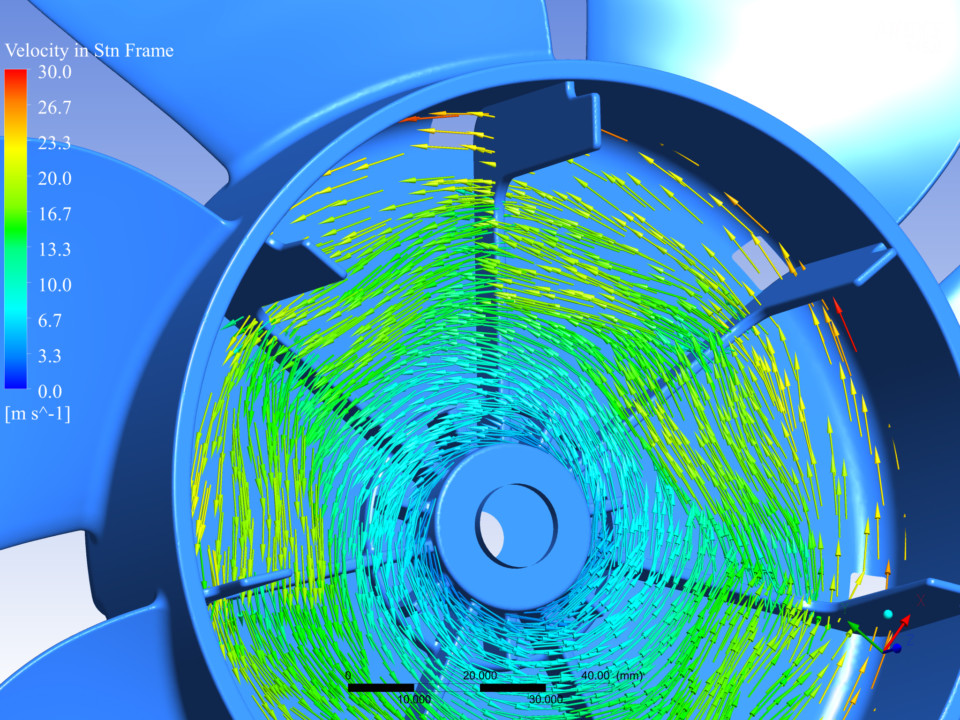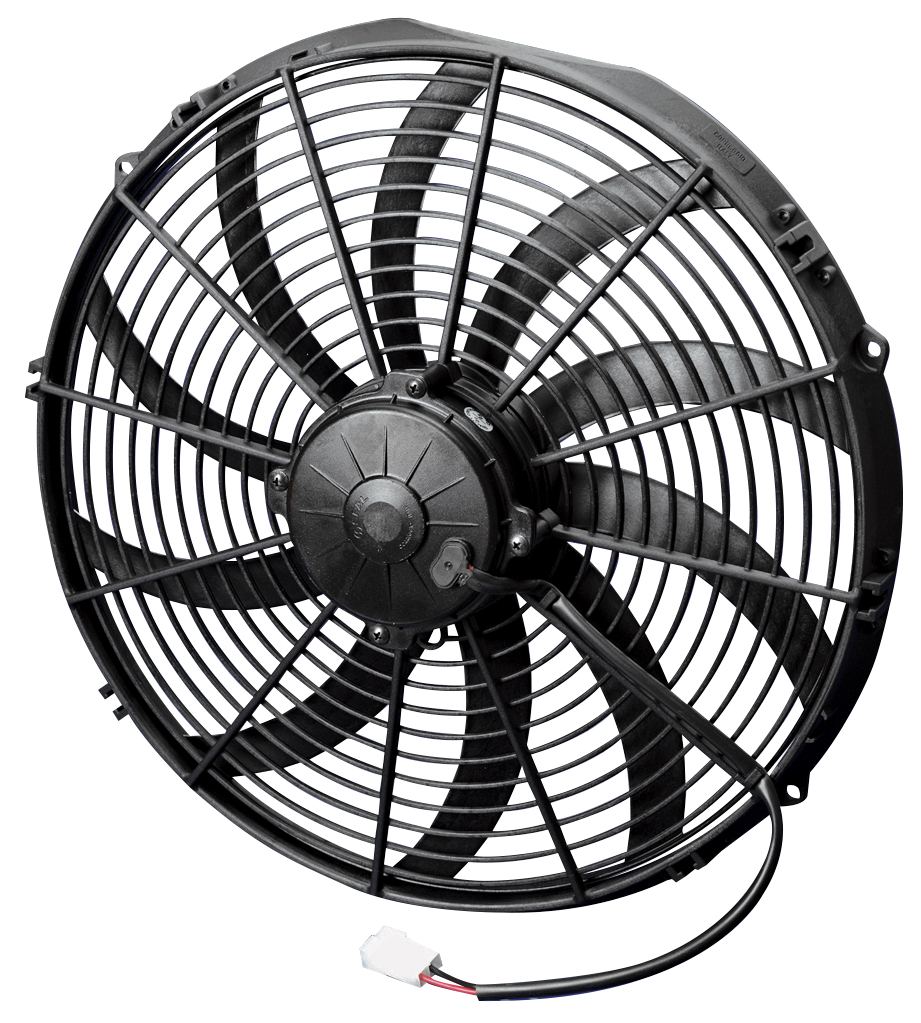A wisely chosen electric fan supplies vital airflow to ensure top performance and maintain reliability for any vehicle. But, a muscle car with a high-performance V-8 and a mechanical fan that’s caught in heavy traffic with high temperatures, can easily overheat. This is because the fan simply cannot increase its speed and produce more airflow when the engine needs it the most. Owners need a powerful, properly-sized electric fan to meet engine cooling requirements, and fit into the available space in front of or behind the radiator.
Several factors need to be taken into consideration when you’re switching from a mechanical to electric fan or selecting a fan for an engine swap or project vehicle. Electric fans must supply a large enough volume of air-flow for a particular radiator/engine combination. Static pressure or equipment/parts that impede airflow needs to be taken into account.
A properly designed shroud should be installed to ensure cooling efficiency. The fan’s size must fit in the space available, and the vehicle’s electrical system must be able to support the increased electrical load of the fan. SPAL has been a trusted industry leader in electric fan performance for decades. The company offers a vast range of fans for almost any engine application or vehicle (street, strip, offroad, race, and more).
More Horsepower, More Heat
A high-performance aftermarket fan delivers far greater airflow than a mechanical fan. Increased airflow is crucial for modified engines, which generate much more heat than a stock engine. A built engine with larger heads, aggressive cam, high-flow intake, and headers often produces 30-to 40-percent more horsepower than stock. A race engine build can double stock horsepower output.
An old OEM brass radiator, water pump, and mechanical fan cannot provide enough cooling capacity for a modified V-8, turbo or supercharged four- or six-cylinder engines. Thus, an electric fan, high-volume water pump and three- or four-row aluminum radiator are not luxuries but necessities. The fan is only one very important link in the cooling system chain.
In most cases, engine builders have ditched clutch fans or flex fans in favor of an electric fan setup for several reasons. A mechanical fan uses a thermostat to regulates a clutch fans to either engage, or disengage, at predetermined temperatures or speed. The clutch only allows the fan to turn at a slightly higher speed than the water pump.
In addition, the clutch is never completely disengaged, so the fan is always turning at about 30 percent of the water-pump speed. Flex fans spin at a 1:1 ratio of the water pump, but that’s still too limiting. Thus, both clutch-driven and mechanical fans are suited for mildly modified engines and should not be used for extreme performance builds.
High-performance electric fans offer a definitive advantage over mechanical belt-driven fans as there is no parasitic drag on the engine. In addition, an electric fan produces far greater airflow at idle or low-rpm, and it saves wear and tear on the water pump. Electric fans also require a fraction of the space a serpentine-driven mechanical fan would. So, these fans also solve many engine packaging and fitment issues in the chassis.
Fan Type
The pusher, puller, and reversible-style fans are the available options. The pusher-style fan mounts on the front of the radiator, and as its name indicates, it pushes airflow through the radiator. However, its mounting location blocks about 20 percent of airflow. These are installed when there simply isn’t enough room to mount the fan between the radiator and engine block. The puller style is far more popular, and efficient because it mounts on the back of the radiator, draws air through, and does not block airflow. The reversible-style fan allows you to mount it either on the front or rear as desired.
Electric fans are rated according to the amount of air that can be streamed through the radiator – this is measured in CFM (cubic feet per minute). In order to find the fan that will work best for your system, you first need to determine that ideal amount of airflow required to meet your cooling capacity. As a guideline, a four-cylinder engine often needs 1300 to 1600-cfm. About 2000 cfm of airflow is suitable for a six-cylinder engine. A small-block V-8 typically uses 2800 to 3000 cfm of airflow, while a big-block V-8 typically requires 4500 cfm. Again, these are just rough guidelines, and not hard-and-fast rules.
Equipment (radiator, A/C condenser, etc) in front of the fan raises the level of static pressure, and it can vary significantly. When radiator thickness and other factors are taken into account, a static pressure estimate can be made. Often it is 0.6 for the thinnest, least restrictive radiator, and 1.2 for the most restrictive radiator, and A/C condenser.
SPAL Application Engineer Brent Chuck said, “We take radiator sizing and spacing into account. We make an estimate of the static pressure of the system by answering some key questions. Does it have air conditioning? How thick is the radiator? What is the distance from the radiator to the engine? What’s the highest performing fan package we could fit into the available space? And lastly, how much current draw is available?
Packaging is one of the biggest issues we run into. Thin fans are not very powerful. It’s better to know the restriction that you’re up against, and then make a good fan decision based on that.”
Keep in mind, the fan should also cover about 70 percent of the radiator core to provide enough cooling capacity to keep up with the engine. When selecting a fan, it’s a good idea to contact the fan manufacturer. When you explain what engine, vehicle, and application you have, a technician can help you determine the best fan for the package.
SPAL offers a complete range of single electric fans up to 16-inches in diameter as well as dual electric fans in various CFM and amp ratings. Dual-electric fans are often selected for high-horsepower vehicles, including forced-air induction applications. Like other manufacturers, SPAL offers straight, curved, and curved-paddle blade designs.
For this article, we will examine similar 16-inch fans in the various blade designs. Each blade design has certain benefits and drawbacks that you need to consider before making a purchasing decision. The amount of air flow at a particular current draw is an important factor. The blades have different widths, profiles, and weights according to design – this effects performance. The height of the blade directly translates into the height/thickness of the fan and in some cases limits which fan can be used in a vehicle.
Three Comparable Fan Models
The Model VA18-AP70/LL-86A is a16-inch straight-blade fan that displaces 1918 cam of air and draws 18.5 amps at 0 static pressure. The lightweight, narrow-blade profile allows for high rpm fan performance. At 3.39-inch total depth, this fan can fit into a tight space, but the straight blade profile creates a fair amount of noise with a less than pleasant tone. Straight blade fans are recommended for applications in which noise is not a major stumbling block. Instead, the fan delivers strong air flow, mounts in a tight space and has a low current draw. While some will tolerate the noise for the volume of air it streams through the radiator, others will not be able to live with the noise.
The curved blade or S-Blade model (VA18-AP71/LL-59A) displaces 2024 cfm, has a 19.5 amp total draw at 0 static pressure. It measures 3.39 inches in total depth. This is a popular choice for many owners because it offers slightly better total airflow performance than the straight blade, but it is noticeably quieter.
The narrow-blade profile is a slightly heavier weight than the straight blade. As a result, it will slightly reduce fan rpm and will require a greater current draw. The curve extends from the center and its design provides more surface area allowing it to push a higher volume of air. However, the curved-blade design is subjected to increased air resistance because the leading edge is longer than a straight blade design.
The curved-paddle-blade model (VA33-AP71/LL-65A) streams 1918 cfm of cooling air and it’s the quietest fan in the group. But the amp-draw rises dramatically to 23.7 amps at 0 static pressure. The paddle blades are larger and heavier than the other designs, so it requires a bigger fan enclosure. It’s also somewhat wider at 3.75 inches. Many muscle car and hot rod owners opt for the paddle-blade design because it delivers a large volume of air and the quietest performance among the three.
All three fan designs will deliver exceptional cooling for most high-performance vehicles and applications. For most owners, the ideal fan offers the best efficiency while meeting static pressure load, amp draw, and fan noise requirements. Many owners will opt for the curved-blade fan that offers better efficiency than the curved, paddle-blade fan, even if the curved-blade fan isn’t as quiet as a curved-paddle-blade fan.
A high-performance engine deserves to be supported by a high-performance cooling system, and the right fan needs to be part of your build plan. For more than four decades, SPAL has a variety of electric fan solutions for your muscle car, classic car, off road vehicle, and so much more. The company has designed and built high-performance electric fans for a wide range of applications, including bus, truck, off-highway, construction, powersports, military, and marine markets. Its fans have also been tested and proven in racing and some of the harshest operating conditions.
If you’d like to find out more about what SPAL has to offer, head over to their website, here.

























